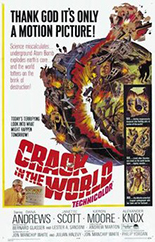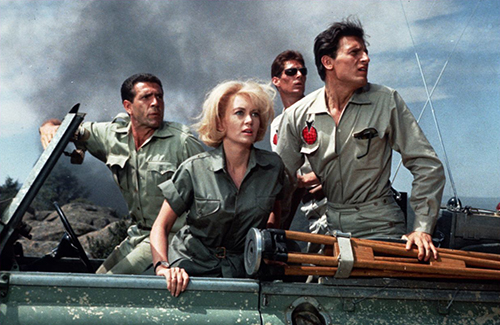
 Crack in the World could have been born from a discussion question in your fifth-grade science textbook: “What do you think would happen if scientists broke through the center of the earth with a nuclear warhead? Explain.” Heck, Crack in the World even uses the requisite 10 words from that chapter’s vocabulary list.
Crack in the World could have been born from a discussion question in your fifth-grade science textbook: “What do you think would happen if scientists broke through the center of the earth with a nuclear warhead? Explain.” Heck, Crack in the World even uses the requisite 10 words from that chapter’s vocabulary list.
Underneath Africa, in a lab not unlike TV’s soon-to-debut Batcave, Dr. Stephen Sorenson (Dana Andrews, The Crowded Sky) runs Project Inner Space, which aims to harness the magma at our planet’s core as a “limitless” energy source. Rather than put a baby in his pregnancy-craving wife, Maggie (Janette Scott, 1963’s The Day of the Triffids), Stephen is obsessed with penetrating the final layer of crust to reach said magma.
His proposed solution — a 10-megaton thermonuclear device — sounds alarms in Maggie’s ex, Dr. Ted Rampion (Kieron Moore, Arabesque), who warns the explosion would cause massive fissures, tidal waves and other stuff that disaster-movie dreams are made of. Secretly terminally ill and thereby obsessed with his legacy, Stephen proceeds anyway.
The mission is a success! If the mission were to hella fuck some shit up ’round the globe. The titular crack in the world forms and begins circumnavigating; if not stopped, Earth will split in two, ending life as we know it. In what amounts to a metaphorical dick-measuring contest, Ted suggests fixing Stephen’s blunder by dropping a hydrogen bomb to effectively cut the crack off at the pass. (Trust me: It makes enough sense within the movie.)
As enjoyable as Crack in the World is, which is close to immensely, I can’t help but think what Irwin Allen would have done with it in his prime — likely something as cataclysmic as the poster depicts. In the hands of one Andrew Marton, then on the verge of becoming Ivan Tors’ go-to director, nothing remotely like that occurs, although he does take out a (model) train of evacuating villagers. Prepare not for an effects spectacle, but for a more sober, science-minded clarion call with a coda that leans hard into biblical overtones. After the near-miss of the Cuban missile crisis, it was just the type of Technicolor reminder the Western world needed. —Rod Lott

